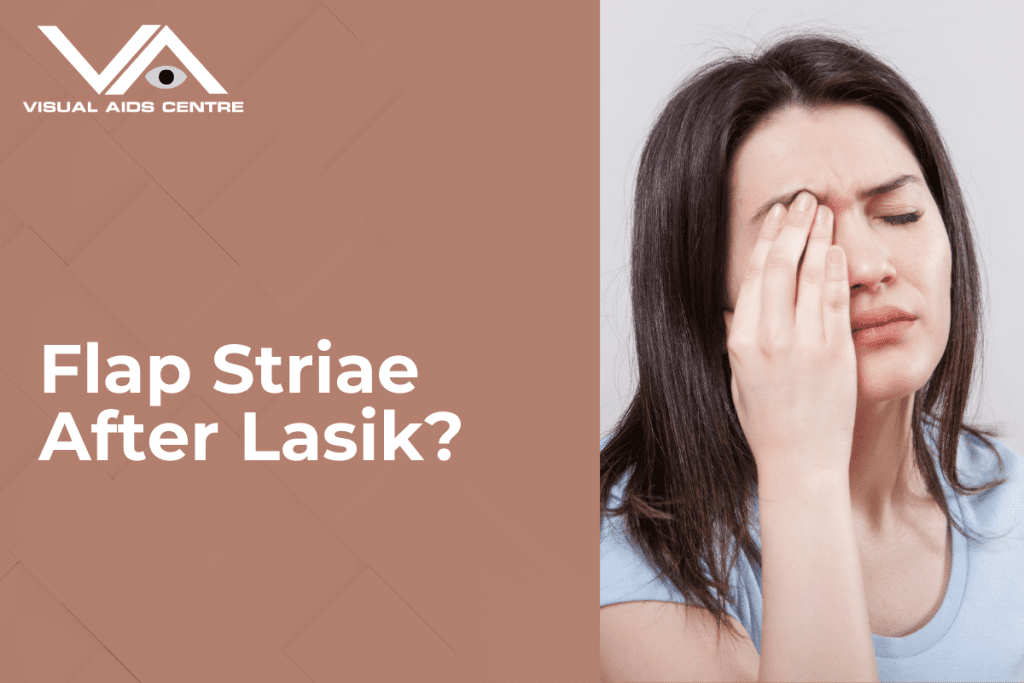Table of Contents
ToggleLASIK eye surgery is known for its potential to dramatically improve vision and reduce the need for glasses or contact lenses. While the procedure has a high success rate, as with any surgical intervention, there are possible complications patients should be aware of. One such post-operative issue is the formation of flap striae, or microfolds, which can occur in the corneal flap created during LASIK. These folds can affect vision and may require attention for optimal visual outcomes.
In this comprehensive exploration, we’ll understand what flap striae are, why they occur, how they can impact your vision and the ways they can be managed.

What Are Flap Striae?
Flap striae, more commonly known as “corneal striae” or “microstriae,” refer to fine, streak-like lines that can appear in the corneal flap following LASIK surgery. The cornea is the clear, dome-shaped surface that covers the front of the eye; during LASIK, a thin flap is created to allow for corneal reshaping.
When this flap doesn’t adhere smoothly to the underlying corneal tissue, it can result in these tiny folds. They can also occur when there is an irregularity or disturbance in the positioning of the flap during the healing process.
Striae may develop soon after the procedure or gradually over time. These disturbances can be minute enough that they’re barely detectable, or they can be significant enough to impact vision.
There are generally two types of flap striae:
- Macrostriae: Macrostriae are larger and more visible folds that can significantly distort vision.
- Microstriae: Microstriae, while smaller and sometimes undetectable without thorough examination, can still cause visual symptoms, such as glare and halos.
Why Do They Occur?
After LASIK, as the eye heals, several factors could lead to the development of flap striae:
- Intraoperative Factors: Complications during the LASIK procedure, such as uneven flap creation, uneven application of the laser, or improper flap replacement, can predispose patients to striae.
- Improper Flap Adhesion: If the corneal flap does not adhere smoothly to the stroma (the underlying layer of the cornea), striae can form.
- External Stressors: Eye-rubbing, trauma, or intense physical activity shortly after surgery might lead to striae.
- Postoperative Healing: The healing process varies for each individual and can affect flap adherence.
- Swelling: Post-operative swelling can create uneven pressure on the flap.
- Surgical Technique: Variations in surgical technique and the inherent structure of the patient’s cornea, including its thickness, curvature, and biomechanical properties can also play roles. Moreover, patients with certain pre-existing corneal conditions or higher refractive corrections may have an increased risk of developing flap striae.
The Impact on Vision
Mild flap striae may not produce any symptoms. However, in cases where the folds are pronounced or centrally located, patients might experience:
- Blurred Vision: This prevalent symptom manifests as distorted straight lines or difficulty in reading text clearly.
- Glare and Halos: Light might scatter differently due to the irregular corneal surface, leading to visual disturbances.
- Difficulty with Night Vision: Contrast sensitivity can be affected, which is critical for low-light environments.
Diagnosis and Monitoring
Eye care professionals typically diagnose flap striae through a meticulous eye examination, often using a slit-lamp microscope for a detailed view of the cornea. They may also utilize advanced imaging techniques, like corneal topography or optical coherence tomography, to assess the extent and position of the striae accurately.
Management and Treatment
For asymptomatic cases without visual complaints, close observation may be all that’s necessary. However, if striae are compromising vision, your ophthalmologist might recommend one of the following treatment approaches:
- Conservative Management: Artificial tears or lubricating eye drops can aid healing in mild cases.
- Flap Massage: Gentle manipulation of the flap can help realign it and smooth out the folds.
- Mechanical Flattening: In the early post-operative period, the surgeon can gently smooth out the flap to reduce striae.
- Flap Lift and Stretch: In more persistent or severe cases that are causing visual disturbances, lifting and repositioning the flap may be necessary. This is usually done under sterile conditions akin to the original surgery.
- Enhancements: Occasionally, additional laser treatment may be required to optimize visual outcomes after striae treatment.
Prevention and Management Tips
While flap striae cannot always be prevented, certain measures can reduce the risk:
- Carefully Following Post-Surgery Guidelines: Avoiding eye rubbing, wearing protective eyewear, and adhering to the prescribed postoperative care can minimize the chances of developing flap striae.
- Early Detection: Regular follow-up appointments with an eye care professional allow for the early identification and management of any complications, including flap striae.
- Choosing an Experienced Surgeon: A skilled LASIK surgeon who follows meticulous surgical protocols may lower the incidence of flap-related complications.
Awareness Leads to Optimal Vision Care
Flap striae post-LASIK can be a concerning complication for patients eager to enjoy improved vision. However, most cases are manageable given the right approach. It’s pivotal for patients to maintain open communication with their LASIK surgeon and adhere strictly to their post-operative care plan. Eye care professionals must remain vigilant in their post-surgical assessments, ready to intervene when necessary to ensure the best possible outcomes for their patients.
Remember, every step in the recovery phase is as crucial as the surgery itself for maintaining the gift of enhanced sight.
For post-LASIK patients and those curious about the intricacies of eye care, it’s essential to stay informed and proactive. Be it through direct conversation with health care providers or through educational resources, understanding potential complications will arm you with the knowledge required to take swift and effective action should the need arise. Remember, in the pursuit of clear vision, awareness and care are your stalwart allies.













